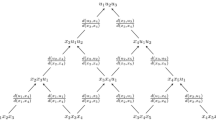Abstract
Using the concept of a symmetric recursive algorithm, we construct a new patch representation for bivariate polynomials: the B-patch. B-patches share many properties with B-spline segments: they are characterized by their control points and by a three-parameter family of knots. If the knots in each family coincide, we obtain the Bézier representation of a bivariate polynomial over a triangle. Therefore B-patches are a generalization of Bézier patches. B-patches have a de Boor-like evaluation algorithm, and, as in the case of B-spline curves, the control points of a B-patch can be expressed by simply inserting a sequence of knots into the corresponding polar form. In particular, this implies linear independence of the blending functions. B-patches can be joined smoothly and they have an algorithm for knot insertion that is completely similar to Boehm's algorithm for curves.
Similar content being viewed by others
References
P. J. Barry (1987): Urn Models, Recursive Curve Schemes, and Computer Aided Geometric Design, Ph.D. Dissertation, University of Utah, Salt Lake City.
R. H. Bartels, J. C. Beatty, B. A. Barsky (1987): An Introduction to Splines for Use in Computer Graphics and Geometric Modelling. San Mateo, CA: Kaufmann.
W. Boehm (1980):Inserting new knots into a B-spline. Comput. Aided Design,12:50–62.
W. Boehm (1983):The de Boor algorithm for triangular splines. In: Surfaces in CAGD (R. E. Barnhill, W. Boehm eds.). Amsterdam: North-Holland, pp. 109–120.
W. Bohem, G. Farin, J. Kahmann (1984):A survey of curve and surface methods in CAGD. Comput. Aided Geom. Design,1:1–60.
W. Boehm (1988):On de Boor-like algorithms and blossoming. Comput. Aided Geom. Design,5: 71–79.
C. de Boor (1972):On calculating with B-splines. J. Approx. Theory,6:50–62.
C. de Boor (1978): A Practical Guide to Splines. New York: Springer-Verlag.
P. de Casteljau (1985): Formes à pôles. Paris: Hermes.
P. de Casteljau (1986): Shape Mathematics and CAD. London: Kogan Page.
T. de Rose, T. Hollman (1987): The Triangle: A Multiprocessor Architecture for Fast Curve and Surface Generation. Technical Report 87-08-07, Computer Science Department, University of Washington, Seattle.
G. E. Farin (1979): Subsplines über Dreicken. Dissertation, TU, Braunschweig.
G. E. Farin (1980): Bézier Polynomials over Triangles and the Construction of Piecewise C-Polynomials. TR/91, Department Mathematics, Brunel University, Uxbridge, Middlesex.
G. E. Farin (1986):Triangular Bernstein-Bézier patches. Comput. Aided Geom. Design,3:83–127.
G. E. Farin (1988): Curves and Surfaces for Computer Aided Geometric Design. New York: Academic Press.
R. N. Goldman (1985):Pólya's urn model and computer aided geometric design. SIAM J. Algebraic Discrete Methods,6:1–28.
W. J. Gordon, R. F. Riesenfeld (1974):B-spline curves and surfaces, in: (R. E. Barnhill, R. F. Riesenfeld eds.) Computer Aided Geometric Design, New York: Academic Press.
J.Hoschek (1987): Grundlagen der geometrischen Datenverarbeitung. Fernuniversität Hagen.
H. Prautzsch (1984): Unterteilungsalgorithmen für multivariate Splines. Dissertation, TU, Braunschweig.
L. Ramshaw (1987): Blossoming: A Connect-the-Dots Approach to Splines. Digital Systems Research Center, Palo Alto.
L. Ramshaw (1988):Béziers and B-splines as multiaffine maps. In: Theoretical Foundation of Computer Graphics and CAD, New York: Springer-Verlag, pp. 757–776.
L. Ramshaw (1989):Blossoms are polar forms. Comput. Aided Geora. Design,6:323–358.
M. A. Sabin (1976): The Use of Piecewise Forms for the Numerical Representation of Shape. Ph.D. Dissertation, Hungarian Academy of Sciences, Budapest.
L. L. Schumaker (1981): Spline Functions: Basic Theory. New York: Wiley.
H.-P. Seidel (1988):Knot insertion from a blossoming point of view. Comput. Aided Geom. Design,5:81–86.
H.-P. Seidel (1989):A new multiaffine approach to B-splines. Comput. Aided Geom. Design,6:23–32.
H.-P.Seidel (1989): Polynome, Splines und symmetrische rekursive Algorithmen im Computer Aided Geometric Design. Habilitationsschrift, Tübingen.
H.-P. Seidel (1990):Symmetric recursive algorithms for curves. Comput. Aided Geom. Design,7:57–67.
E. Stark (1976): Mehrfach differenzierbare Bézier-Kurven und Bézier-Flachen, Dissertation, TU, Braunschweig.
Author information
Authors and Affiliations
Additional information
Communicated by Carl de Boor.
Rights and permissions
About this article
Cite this article
Seidel, HP. Symmetric recursive algorithms for surfaces: B-patches and the de boor algorithm for polynomials over triangles. Constr. Approx 7, 257–279 (1991). https://doi.org/10.1007/BF01888157
Received:
Revised:
Issue Date:
DOI: https://doi.org/10.1007/BF01888157




